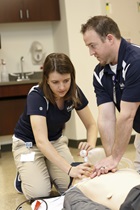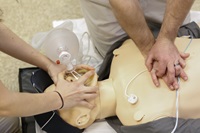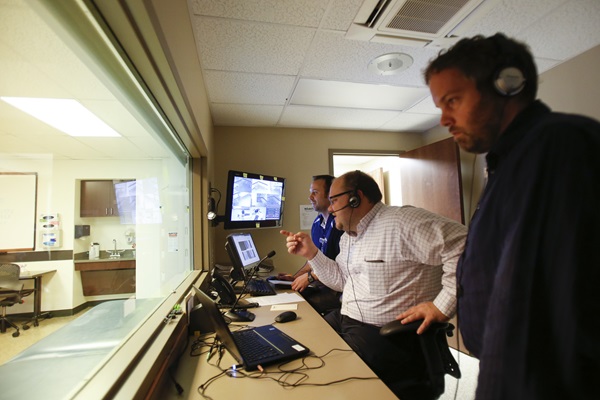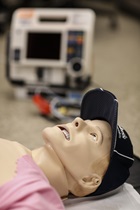St. Luke’s Athletic Trainers Practice to Make Perfect
March 27, 2017
Bethlehem, PA (03/27/2017) – Brandon Bushnell, head athletic trainer for Wilson School District, jumped back for a brief second with a startled reaction while undergoing some of the latest training and review in life saving techniques implemented by St. Luke’s University Health Network for its athletic training staff.

Working with a partner on a resuscitation manikin, Bushnell performed CPR compressions, breaths and used an AED to deliver an electrical charge to re-start the heart. He went back into CPR mode when his startled reaction occurred.
“We started getting sound effects of an athlete groaning,” he said. “Like he was coming to and talking. I didn’t know what was going on for a couple of seconds, and then the eyes opened. I kind of jumped back as I checked the pulse, and it was going.”
Bushnell and other athletic trainers at St. Luke’s undergo training at the Network Simulation Center to help improve patient safety and quality care through the use of simulation and clinical skills. The Network Simulation Center provides real-life scenarios with the lifelike manikins by controlling vital signs and accurately measuring the force and effectiveness of chest compressions, ventilation volume and AED use.
The St. Luke's Simulation Center uses Laerdal SimMan 3g and Laerdal QCPR full body manikins to create a realistic environment for practice and training of essential skills. Athletic trainers potentially may treat cases like commotio cordis, when an athlete is struck in the chest by a ball or sustains a blow that disrupts the heart rhythm causing ventricular fibrillation, and these simulations allow us to replicate critical scenarios with patients. The mortality rate for such injuries without quick identification and treatment including an AED is extremely high.

Objective feedback includes proper compression of the chest, the force of ventilation and safe and proper use of the AED. Such training carries over into real life when critical situations require delivering accurate compressions and breaths. It’s like going out to practice that ideal golf swing or ideal putt. The more practice you perform the proper way, the better you get at it. Perfect practice makes the performance perfect.
“Simulation has been shown to improve clinical judgment and reduce errors while increasing patient safety,” said Megan Augustine, director of the Network Simulation Center. “Advantages of a simulation using high-fidelity [high degree of realism] simulators or SPs include, but are not limited to, enhanced communication skills, critical thinking, clinical decision making and skill practice.”
CPR recertification is required every two years and in the past, performed on half-body manikins. But the manikins available in the Network Simulation Center are full body with numerous variables, just like a real patient.
“The biggest thing we take away from this training is reflection,” said Jim Reidy, program manager, Athletic Training. “We videotape our athletic trainers doing this, and they can appraise how they did. They go through the simulation and get feedback. They can pick up what they did right, what they did wrong and ways to do it properly in the future.”“You put yourself in a real-life scenario,” Reidy added. “When there’s an emergency on the field, athletic trainers are often the first responders -- even before the ambulance and EMS personnel arrive. Many things can be going on, but we have to work through our assessments quickly to make good decisions.”

Utilizing the Network Simulation Center allows St. Luke’s athletic trainers to experience more realistic on-field situations and be better prepared to handle a life-threatening emergency with the best possible patient care. This realistic training enables St. Luke’s athletic trainers to better serve our patients, schools and community.
About St. Luke’s
Founded in 1872, St. Luke’s University Health Network (SLUHN) is a non-profit, regional, fully integrated and nationally recognized network providing services at seven hospitals and more than 270 outpatient sites. The network’s service area includes Lehigh, Northampton, Carbon, Schuylkill, Bucks, Montgomery, Berks and Monroe counties in Pennsylvania and Warren County in New Jersey. Dedicated to advancing health education, St. Luke’s operates the nation’s oldest School of Nursing and 22 graduate medical educational programs and is considered a major teaching hospital, the only one in the region. In partnership with Temple University, St. Luke’s created the region’s first Medical School. Repeatedly, including 2017, St. Luke’s has earned Truven’s 100 Top Major Teaching Hospital designation as well as 50 Top Cardiovascular program in addition to other honors for clinical excellence. St. Luke’s is a multi-year recipient of the Most Wired award recognizing the breadth of St. Luke’s information technology applications such as electronic medical records, telehealth, online scheduling and pricing information. St. Luke’s is also recognized as one of the state’s lowest cost providers in comparison to major teaching hospitals and other health systems.
Read More NewsLatest News

December 30, 2025
SLUHN Joins National Study on New Shoulder Replacement Technology

December 23, 2025
St. Luke's Top Baby Names for 2025

December 17, 2025

